A thermometer that goes to 200 million degrees Understand article
Measuring the temperature inside a fusion reactor is no easy task. Find out how it’s done – and even simulate it in the classroom.
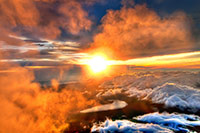
/ Flickr
The Joint European Torus (JET) is the world’s largest fusion energy experiment, pioneering methods for producing plentiful, clean power with the same method used by the Sun: fusing light atoms such as hydrogen together to form the heavier atom helium.

two hydrogen nuclei fuse to
form a deuterium nucleus, a
positron and a neutrino. The
positron quickly encounters
an electron, they annihilate
each other, and only energy
remains. The deuterium
nucleus goes on to fuse with
another hydrogen nucleus to
form helium-3. In the final
step, two helium-3 nuclei
fuse to form helium-4 and
two hydrogen nuclei. Click on
image to enlarge.
Image courtesy of Mark
Tiele Westra
In fact JET, in the UK – and its larger successor ITER, being built in the south of France – aims to operate thousands of times more efficiently than the Sun, even though this requires creating temperatures in the heart of the fusion vessel that are ten times hotter than the core of the Sun.
Amazingly enough, scientists and engineers have devised ways of heating hydrogen fuels to these temperatures, and then preventing them from melting the vessel by controlling them with very strong magnetic fields (as described in Rüth, 2012). Fundamental to these experiments are methods not only for monitoring the reactions (see Dooley, 2012) but also for measuring the temperature profile of the fuel, from its scorching core to the cooler edges, so that researchers can create the optimum environment for fusion to occur.
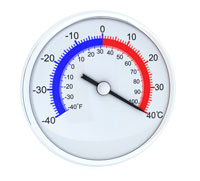
the temperature in a fusion
vessel? A conventional
thermometer would melt in
microseconds.
Image courtesy of alxpin /
iStockphoto
At these temperatures the hydrogen fuel becomes the fourth state of matter, plasma. Measuring the temperature of a plasma that is ten times hotter than the Sun presents some challenges – you can’t simply insert a conventional thermometer: it would be melted in microseconds. Things are further complicated because plasma is made up of two very different charged particles: electrons that have been stripped from atoms, and the heavier positive ions formed by the removal of the electrons. The key to fusion is to create hot ions that will fuse, but electrons can respond to the heating systems differently to ions – and can end up at a different temperature! The complex interactions between electrons and ions can affect the success of a fusion experiment significantly.
Despite these challenges, plasma physicists have developed multiple methods for deducing the temperature (figure 1) – cross-checking the results of different methods increases the reliability of your measurements – so that they can be confident that they are in control of what goes on inside one of the hottest places in the Solar System.
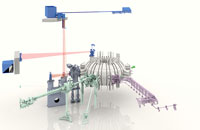
of the JET experiment, showing
only the temperature-measuring
systems. Electron cyclotron
emission (pale purple), LIDAR /
Thomson scattering (red), charge
exchange (bright green), and
X-ray spectroscopy (pale green).
Click on image to enlarge.

of the LIDAR signal through
the plasma: the laser
enters horizontally from
left. A detector at the top
of the vessel picks up light
from this laser, which is
scattered by electrons.
Click on image to enlarge.
Images courtesy of EFDA
Electron temperature
Loop-the-loop: electron cyclotron emission
The first ‘thermometer’ relies on the effect that magnetic fields have on charged particles. Because they are charged, electrons are forced to spiral along the magnetic field lines, which creates microwaves called cyclotron emission (figure 2). The hotter – and therefore faster-moving – the electrons are, the more intense are the microwaves that they emit.
The microwaves also yield a profile of the electron temperature, due to the varied magnetic field in the vessel: the stronger the field, the higher the spiralling frequency. A scan of intensity against frequency tells us the temperature for each magnetic field strength. Combining this with a spatial map of the magnetic field strength, created by other systems, gives us a profile of the electron temperature.
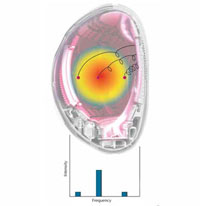
emitting radiation at the frequency of their oscillation. The stronger the magnetic
field (i.e. towards the pole of the torus – the hole in the doughnut), the tighter
the helix, which results in a tighter spiral and therefore a higher frequency emission.
The intensity of the radiation is determined by the speed at which the electrons are travelling
– that is, their temperature. The hotter the plasma, the stronger the signal. The magnetic
field strength is already known from other measurements not discussed here, and so the
distribution of the plasma temperature can be calculated by correlating frequency against intensity.
Click on image to enlarge.
Image courtesy of EFDA
Speed trap! LIDAR
JET’s second ‘thermometer’ uses a system similar to a police speed camera to measure the speed of particles, except that it uses laser light (LIDAR) instead of radio waves. Light from the laser is scattered by the electrons in a process known as Thomson scattering; if the electrons are moving, then the scattered light will be Doppler shifted (figure 3). We are more familiar with Doppler shifts of sound: the sound from passing cars has a slightly higher pitch as they move towards us than when moving away. Similarly, if light is scattered by moving electrons, its frequency (colour) will be Doppler shifted to higher frequencies for the electrons moving towards the detector and to lower frequencies for those moving away. The faster the electron moves, the bigger the frequency shift.
The cumulative effect of the many electrons in the plasma – some moving towards and others away from the detector – is that the original narrow frequency band of the laser light is broadened (figure 1B). The extent of broadening tells us the speed of the electrons, and hence their temperature.
A two-dimensional profile of the temperature is created by combining data from a number of beams fired at different angles through the plasma. This is similar to the creation of 2D computed tomography images from multiple individual X-rays.
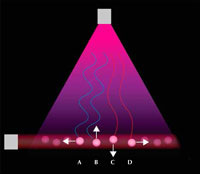
absorbed and then re-emitted by electrons, and a detector above the beam picks up the fraction
of light emitted upwards. The motion of the electrons relative to both the laser beam and the
detector causes the scattered light to be Doppler shifted from the original laser frequency either to
higher or to lower frequencies, depending on the direction of motion.
Electron A is moving towards the laser and therefore absorbs blue-shifted radiation, while electron
D is moving the opposite way, and absorbs red-shifted light, which is then scattered at the absorbed
wavelength. Electrons B and C are not moving relative to the laser, so the light they absorb is at the
original frequency. However, because of their motion towards and away from the detector, respectively,
the re-emitted light is Doppler shifted to the blue or to the red, as shown.
Click on image to enlarge.
Image courtesy of EFDA
Ion temperature
Unfortunately LIDAR is not an effective way of measuring ions. This is because the process of Thomson scattering relies on the induced oscillations of a charged particle. The heavier ions oscillate less – they are not tossed about by the laser light waves as much as the lighter electrons.
The greater mass of the ions also means that their cyclotron frequency is too low to be useful – the waves are too long to give a precise measurement and they happen to coincide with the plasma’s natural absorption frequency so they do not escape the plasma cleanly.
In addition, the hydrogen ions in a plasma effectively become invisible, because all their electrons are stripped off, disabling the common mechanism of radiation creation – electrons jumping between orbits.
However, a route to working out the temperature has been found via impurities in the plasma; while undesirable in large quantities, traces of impurities can be useful for this purpose.
Partner swapping: charge exchange
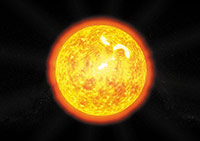
inspired by the Sun, which
fuses light atoms such as
hydrogen into heavier atoms,
releasing energy in the
process.
Image courtesy of EFDA
One of the most common contaminants in plasma is carbon, which was JET’s wall lining until 2010. Although the carbon tiles have been replaced with beryllium and tungsten, there are still traces of carbon in the plasma. Usually the carbon is invisible, like the hydrogen, but it can be made visible in a process called charge exchange. This involves shooting a beam of neutral hydrogen atoms into the plasma at high speed. When these atoms encounter a carbon ion, sometimes an electron jumps from a hydrogen atom across to the carbon, which then emits a nice sharp spectrum that is easy to measure.
Because of the high temperature, the carbon atoms are moving very fast in all directions, so the sharp frequencies of the spectrum are then spread out in the same way as the scattered LIDAR signal is (figure 3).
X-Ray eyes: tungsten impurities
A second method for measuring the temperature of the ions – again based on impurities – has recently been commissioned at JET: a new X-ray detector. Tungsten inevitably gets knocked off the new tiles in the wall and contaminates the plasma in small amounts. Unlike the light atoms, hot tungsten typically retains about half of its 74 electrons even in the extreme heat of the core of the plasma, and so does not become invisible – these electrons jump between electron shells and emit X-rays. Doppler broadening of this X-ray spectrum caused by the movement of the ions allows the temperature to be calculated (as in figure 3).
The temperature profiles from these four systems are essential for analysing the effectiveness of the heating systems in use at JET – some of which heat electrons, while others work on the ions. The measurements also give vital information about how energy in the plasma behaves in different circumstances, including how the electrons and ions interact with each other. Using this knowledge, JET’s scientists and engineers can manipulate the plasma to maximise the energy confinement, thereby creating and maintaining optimal conditions for fusion.
Demonstrating the Doppler effect
To create your own Doppler shift, you will need a small battery-powered sound source that can emit a long tone or set of tones of a constant pitch. A small alarm clock or a mobile phone with a single-tone ring or alert will do nicely. Then you need a long sock or stocking – the longer the better – and lastly, plenty of space!
Standing in the middle of your space, start the alarm clock ringing, then drop it into the stocking and swing it around your head as fast as possible. Other people will hear the pitch varying as the sound source moves towards and then away from them. If you are doing the swinging, you will notice no difference, as the sound source is moving neither towards nor away from you, but at right angles to you.
More about EFDA-JET
The Joint European Torus (JET)w1 investigates the potential of fusion as a safe, clean and virtually limitless energy source for future generations. It can create the conditions (100-200 million °C) in the plasma sufficient for fusion of deuterium and tritium nuclei to occur, and it has achieved a maximum fusion power output of 16 MW. As a joint venture, JET is collectively used by more than 40 European fusion laboratories. The European Fusion Development Agreement (EFDA) provides the platform to exploit JET, with more than 350 scientists and engineers from all over Europe currently contributing to the JET programme.
EFDA-JET is a member of EIROforumw2, the publisher of Science in School.
References
- Dooley P (2012) Seeing the light: monitoring fusion experiments. Science in School 24: 12-16.
- Rüth C (2012) Harnessing the power of the Sun: fusion reactors. Science in School 22: 42-48.
Web References
- w1 – Learn more about EFDA-JET.
- w2 – EIROforum is a collaboration between eight of Europe’s largest inter-governmental scientific research organisations, which combine their resources, facilities and expertise to support European science in reaching its full potential. As part of its education and outreach activities, EIROforum publishes Science in School.
Resources
- Warrick C (2006) Fusion – ace in the energy pack? Science in School 1: 52-55.
- For an introduction to the electromagnetic spectrum – and how it is used in astronomy – see:
- Mignone C, Barnes R (2011) More than meets the eye: the electromagnetic spectrum. Science in School 20: 51-59.
Institutions
Review
This article describes four methods that are used by the world’s largest fusion energy experiment to deduce the temperature inside the fusion vessel. Due to the high temperatures involved, any thermometer would melt instantly.
The four methods involve concepts from several areas of physics and chemistry, including optics, electromagnetism, mechanics, energy and atomic structure. In addition, a classroom activity based on the demonstration of the Doppler effect is presented, which partially explains some of the four methods.
The Science in School series of fusion articles, of which this is one (see the resources list), has great interdisciplinary potential for upper secondary-school students, as the articles could be used to discuss fusion energy: as a source of future sustainable energy, how it works, and its advantages and disadvantages.
Mariana Martinho, Portugal





